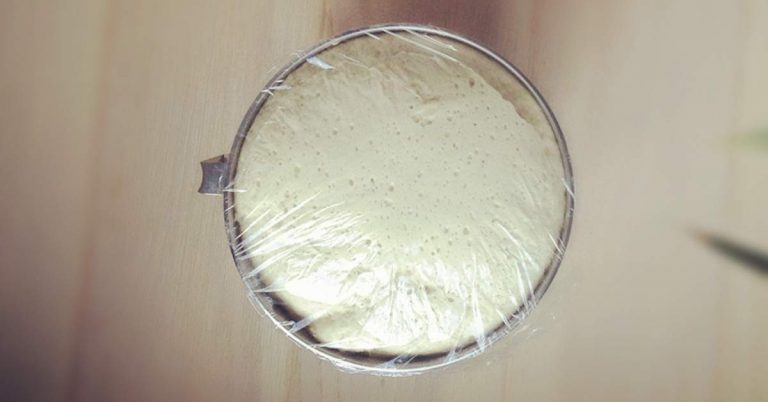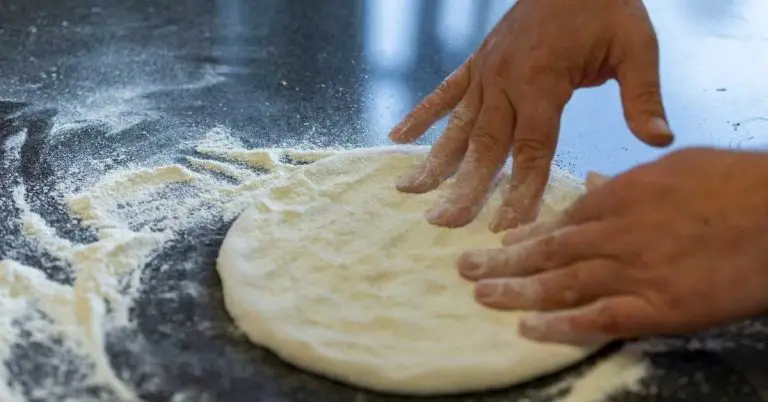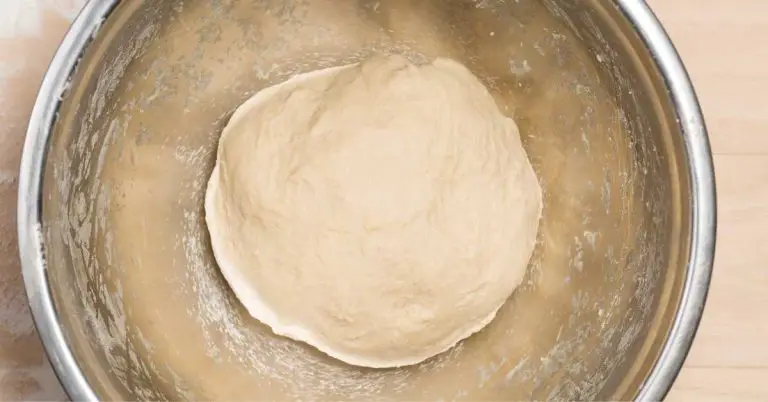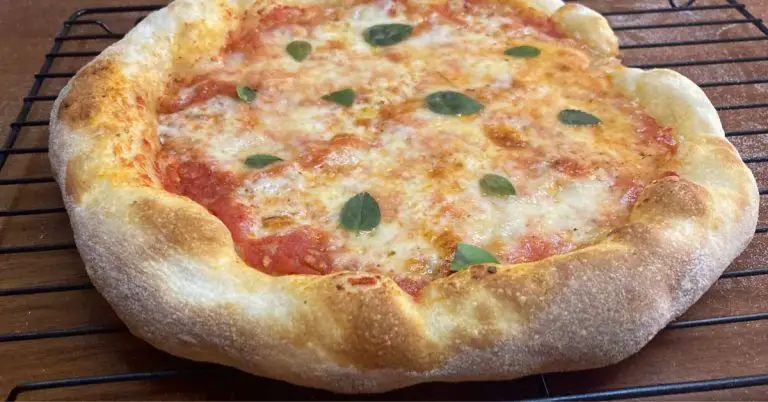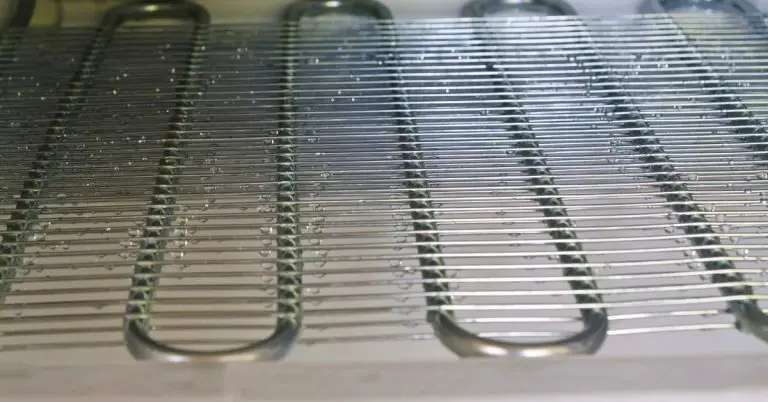Why Your Homemade Pizza Crust Is Too Hard: How To Make Pizza Crust Softer
Making great pizza at home that actually tastes good isn’t as easy as it sounds. One of the most common complaints home pizza-makers have is that their crust turns out brittle, hard, and dry. Thankfully, there are easy ways to address this.
In my experience, the primary cause of hard crust is because it’s been baked for too long at a low temperature. This usually happens because you’re waiting for the crust to darken before taking it out of the oven, which leads to a tough pizza with a hard and dry crust.
The best way to fix hard pizza crust is to speed up the cooking process by using a pizza steel or pizza stone. You can also make small tweaks to the recipe, both to increase the pizza dough hydration and to improve browning at lower temperatures.
Each of these steps are easy to implement and will help your pizza to cook and brown faster so that when the pizza is cooked, there’s still some moisture left in the crust.
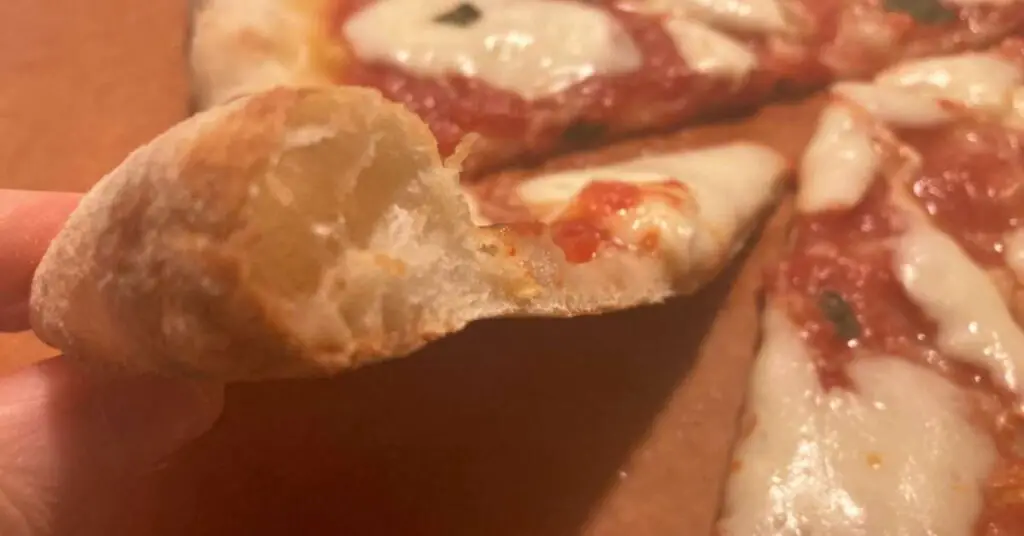
Related Post: How Pizza Dough Should Look
Your Pizza Crust Is Too Hard Because It Was Baked For Too Long
If you read most pizza recipes online, they’ll have you waiting for the crust and cheese to brown before taking it out of the oven. This makes sense in theory, but if you missed some steps along the way (or they weren’t included in your recipe), you’ll be waiting way too long for this to happen. This is often what causes pizza crust to become hard.
Think about it: the longer your pizza cooks, the more moisture is evaporated from the crust and toppings. This is the primary reason your pizza crust becomes too hard.
In a super hot oven (like a pizza oven), this isn’t really an issue because the temperature is so high that the pizza cooks and browns super fast. But in a regular home oven at 500F, it’s a completely different story. At these low temperatures, you’ll need to take some extra steps to get the crust to cook and brown faster before it gets too hard.
How To Get A Soft, Crispy Pizza Crust (That Isn’t Hard): 6 Easy Ways
To be clear, it’s not just about speed, it’s about results. We want a pizza crust that’s browned and crispy on the outside while still soft and chewy in the middle. This means we need to do a few things that will help your pizza crust cook faster, brown faster, and retain more moisture in the process, before it becomes too hard.
- Use A Pizza Stone or pizza steel: A pizza stone or steel is a tool you can use in your regular home oven to make it work more like a dedicated pizza oven. It’s basically just a big slab of stainless steel (or cordierite stone) that gets super hot when preheated, so when you bake your pizza on top of it, the crust starts to cook and get color immediately. No matter what style of pizza, I always recommend using a pizza steel in a home oven.
- Add honey (or sugar) to the recipe: Most online pizza dough recipes call for sugar, but if your recipe doesn’t, you should consider adding it. At lower temperatures, pizza crust takes a very long time to brown, by which point it’s dried out and hard. A bit of honey (or sugar) helps to caramelize the crust even at lower temperatures, so you’ll get some nice color without having to overcook it.
- Add olive oil to the recipe: Like sugar, olive oil is another ingredient that helps pizza crust crisp and brown faster at lower temperatures. It also keeps the dough nice and pliable as you work with it.
- Use more water in the dough: The longer a pizza cooks, the more moisture it loses. So logically, the easiest way to address this is to add more water to your recipe. You can do this by using a high-hydration pizza dough recipe of around 70%, compared to the 50% or so you find in the most popular online recipes. This is enough water to keep your pizza crust soft.
- Use less yeast: The more yeast you use, the more sugars it will consume from the flour. This slows down browning and increases baking time. Unlike most recipes which call for a whole packet of yeast, a 1/4 to a 1/2 teaspoon (or 0.5 to 1.5 grams) is often all you need. A slow rising pizza dough with a longer fermentation period always works best.
- Increase the oven temperature: Sometimes the solution is as easy as turning up your oven. Most recipes tell you to bake the pizza at around 450F, but that’s just too low, especially when you consider how inefficient many home ovens are. I recommend the maximum temperature your oven is capable of to help speed up the cooking time and prevent the crust from drying out.
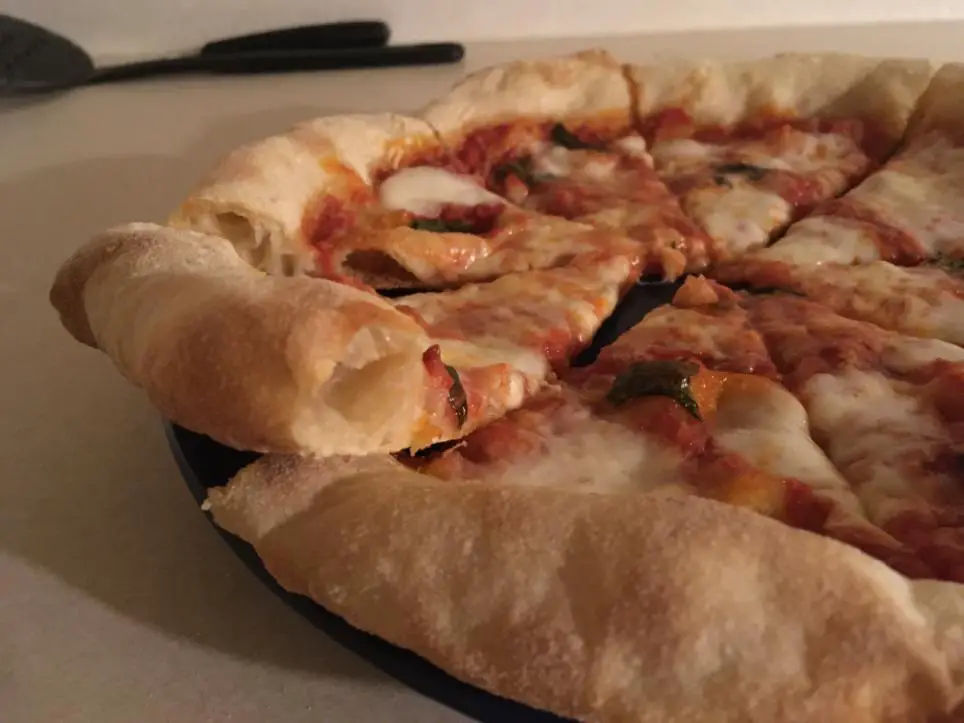
Your Pizza Crust Is Too Hard Because You Mishandled The Dough While Shaping It
Sometimes pizza crust comes out of the oven hard even if you’ve used a great recipe and a pizza steel. This usually happens because the dough wasn’t stretched properly. This increases the cooking time and prevents quick browning.
On any pizza crust, the highest and thinnest points will brown the fastest. This is why air pockets in the dough are often the darkest and crispiest spots on the finished crust. On the other hand, a flat and dense dough will crisp and brown much more slowly.
The key to a great crust is a great dough. The way you make the dough (and knead the dough) all has a big impact on the finished product.
The key to addressing this is a properly stretched dough, preferably by hand. When you do this, your pizza base will fill with air and rise as it cooks, giving you a crispy, golden brown crust before it gets too hard.
When a pizza crust is cooked correctly, you should be able to press down on it and watch it spring back without cracking. But this can be difficult to do if you want the crust to be crispy and browned at the same time.
How To Shape Your Pizza Dough Correctly For A Soft Crust
To get a pizza crust that browns in the oven before getting too hard, you need to preserve as much air and gas in the dough as possible. There are a few ways to do this that aren’t too difficult, even for a novice pizza chef.
- Don’t use a rolling pin: Even though most online recipes call for using a rolling pin, it’s actually a terrible way to make pizza at home. A rolling pin will just squeeze all the air and gas out of the dough and burst all those nice bubbles you created during proofing. A flat, dense dough won’t brown very easily.
- Stretch the dough by hand: When you stretch pizza dough by hand, it’s much easier to preserve all those air and gas bubbles. Try working from the middle outwards to push the air into the edges, then carefully stretch it over your knuckles. Refer to the video below if you need a visual guide.
- Use less flour: Just like using more water helps prevent hard pizza crust, using too much flour works the same way but in reverse. Sticky dough is difficult to handle, so it’s natural to want to add more flour as you work with and knead it. But when you increase the amount of flour, this will cause the dough to become too dry. Try to avoid this by using a dough scraper instead of your hands, and coating your dough ball in semolina flour so doesn’t stick to the counter. For a visual guide to doing this, refer to the video below.
- Let it rise longer: When you let the dough rise longer, the air bubbles that form will brown faster before the pizza crust gets hard. More on this below.
Tip: Using a dough scraper is an essential tool for dealing with sticky dough. This can help you avoid using as much flour as you might have otherwise.
A Proofed And Rested Pizza Dough Cooks Into A Softer Crust
All that hot air and gas necessary to make a perfect pizza we talked about in the last section doesn’t just come from nowhere. It’s actually a result of a chemical process that happens when yeast is mixed with flour and water.
This is what the resting and proofing stage of making pizza dough is all about. The longer the dough rests after you knead it, the more gas and air will build up inside the dough.
If you don’t let your pizza dough proof long enough, there won’t be any gas built up and the crust won’t rise. When pizza crust doesn’t rise it, it comes out flat and dense and hardens before it browns.
This means, even if you use a great recipe, stretch by hand, and use a pizza steel, your pizza crust will still be too hard if it hasn’t proofed long enough.
Proofing is basically just letting the pizza dough rest after you shape it into a ball. Typically, this is done by placing the freshly shaped dough ball in a sealed and lightly oiled container for several hours. During this time, the dough ball will relax and fill with air and gas. Proofing helps the pizza crust cook and brown faster so it stays soft even after it’s fully baked.
You can see exactly how I shape the dough for balling and proofing in the video below:
You can find more information with pictures about shaping and working with a wet dough ball here.
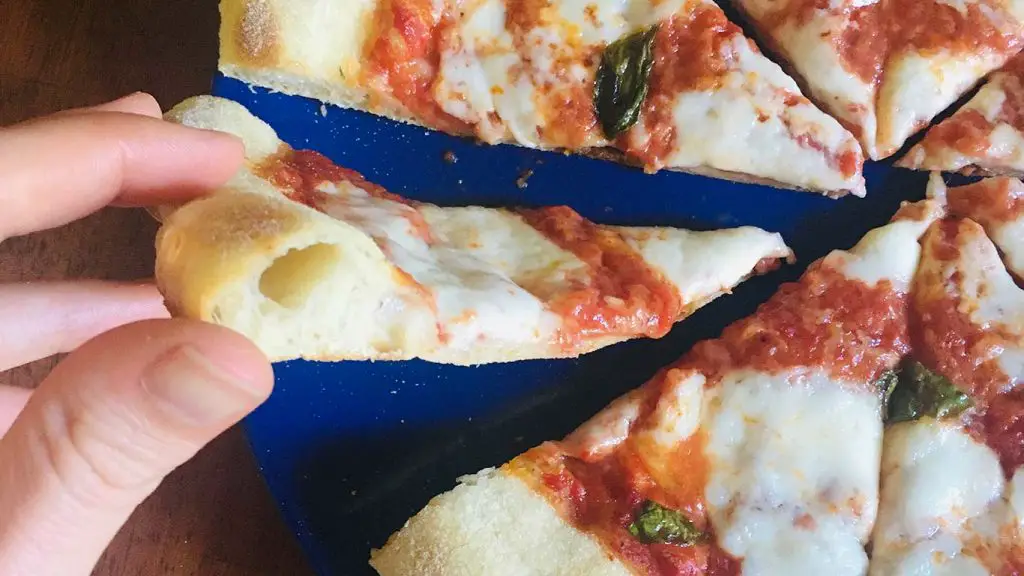
Keep in mind, balling and proofing the dough comes after you knead it and let it rise for the first time. So these steps usually come hours (or even days) after you initially make the dough. You should always proof your dough at room temperature.
Consider Investing In A Pizza Oven
Making pizza in a home oven is great, but if you want to make your crust as soft as possible (while still being crispy) every time, you should consider buying a pizza oven. Pizza ovens are the easiest way to make pizzeria quality pizza at home.
A dedicated pizza oven will even let you cook Neapolitan style pizza right at home, which is known for its soft and delicate crust.
Ooni Has Lots of Options
Almost any pizza oven will work better than a home oven, but it’s certainly true that some are better than others. Ooni pizza ovens are my personal favorite because they have lots of options for different pizza preferences and budgets.
You can check out my full breakdown of all Ooni pizza oven models here.
Final Thoughts
There’s nothing worse than a pizza with a crust that’s hard and dense instead of soft and fluffy.
Pizza crust is supposed to be the crown of the slice not the stuff you leave behind on your plate.
Don’t worry about the flour you’re using or brushing the dough with water halfway through the bake like you see recommended on some other blogs and forums. Instead, just focus on the basics – a highly hydrated dough (without too much flour), a pizza steel, ample proofing, gentle shaping, and a shorter bake time.
Follow my advice and you will be cooking soft, airy, and delicious pizza right in your home oven.
Related Questions
Does Too Much Gluten or Kneading Cause A Hard Pizza Crust?
In my experience, the amount of kneading or gluten that’s been built up in the crust will not affect how hard or soft the pizza crust will be once baked. If you dough has been over-kneaded it may be more difficult to work with, but as long as you have the proper hydration and resting period it should remain soft when baked. This is because the gluten bonds simply affect how elastic the dough is and not necessarily the hardness of the crust. Your pizza may be slightly chewier with a high gluten content, but it should still remain soft as long as it isn’t baked for too long.
Does The Flour Type Make Pizza Crust Hard Or Soft?
In my opinion, the flour type does make a difference in the consistency of the crust, but not necessarily how soft it is. If you compare Tipo 00 flour with bread flour or all-purpose flour, the Tipo 00 will create a much more delicate pizza crust. But that doesn’t mean all-purpose or bread flour can’t have a nice soft crust as well. The differences in flour mostly comes down to the fineness of the milled grain and the protein content. Both larger grains and a high protein content can still make for a softer pizza crust if the moisture level and proofing is done correctly. But these less refined grains will produce a heavier and less digestible crust compared to Tipo 00.


